Stock enhancement program steadily improving
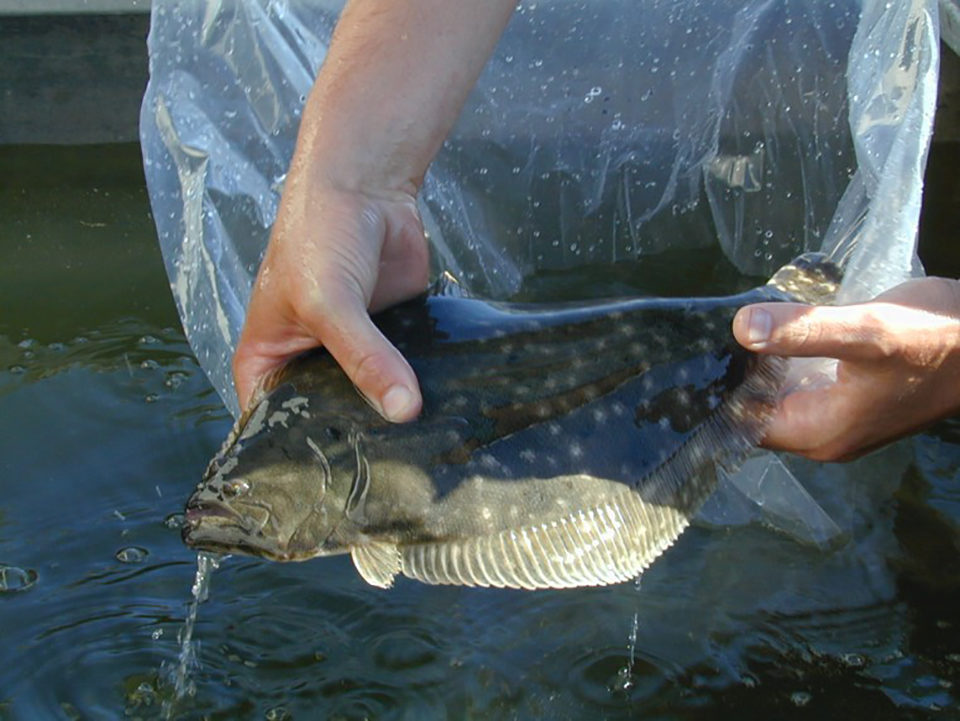
The Southern flounder (Paralichthys lethostigma) is one of the top three recreationally fished marine species in Texas (USA), along with red drum (Sciaenops ocellatus) and spotted sea trout (Cynoscion nebulosus).
Over the last 25 years, Southern flounder populations have steadily declined, leading to various fisheries implementation measures enacted by the Texas Parks and Wildlife Department (TPWD). In addition to fishing regulations and other fisheries management strategies, the agency established a stock enhancement plan of action to supplement the declining natural populations.
The program was initiated in 2006 with ongoing production efforts since 2009. TPWD hatcheries producing Southern flounder for stock enhancement are the Coastal Conservation Association Marine Development Center (MDC) in Flour Bluff, Texas, and Sea Center Texas (SCT) in Lake Jackson, Texas.
Broodstock management
Wild Southern flounder broodstock are captured from Texas bays and maintained at the hatcheries. The captive broodstock are fed a combination of cut squid, Atlantic mackerel and shrimp three times a week (Monday, Wednesday and Friday). In addition, a prepared vitamin and mineral gel mixture is provided to supplement the regular diet. Feed is distributed in the tank and the flounder typically consume the feed while it floats in the water column. The flounder are sight feeders and visually identify their prey items prior to consumption.
Aggressive feeding behavior is demonstrated when the flounder swims up into the water column, attacks the feed while swimming in an S-shaped motion, and then returns to the bottom. Sometimes flounder may feed at a slower rate and eat feed that sinks down to the bottom of the tank. Once the flounder have had their fill, a few pieces of feed remaining on the bottom of the tank indicates that the feeding event has ended. About 10 minutes should be allowed for the flounder to feed off the bottom of the tank.
At TPWD hatcheries, captive flounder broodfish are strip-spawned from November through March. Spawning through use of photoperiod/temperature maturation cycles has been successful, but not consistent enough to supply eggs as needed. Therefore, most of the captive spawning activities conducted have relied on using hormone-induced strip-spawning techniques.
The criterion used to identify eligible female broodfish for spawning is based on four stages of gonadal development. External signs of Stage 1 include little to no visible swelling of the abdomen; Stage 2 is indicated by some abdominal swelling but covering no more than half of the abdomen; Stage 3 is indicated by easily observable or large swelling of the abdomen extending almost all the way to the caudal fin; and Stage 4 is indicated by abdominal swelling that extends all the way to the caudal fin and a clear or colorless liquid around the oviduct region may be present.
Females are graded prior to hormone injections. Females identified as being at Stages 3 or 4 are injected with gonadotropin-releasing hormone. The hormone is injected into the muscle between the lateral line and the dorsal fin at a dosage of 50 to 100 μg/kg (Fig. 1). About 48 hours after injection the strip spawning procedures may begin.
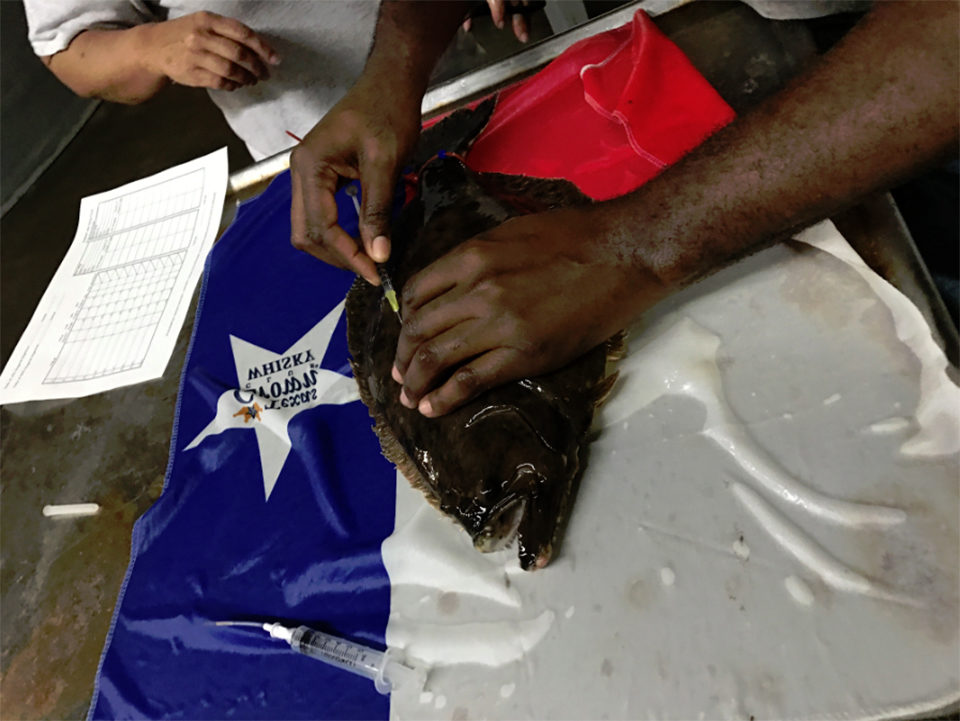
Egg collection and fertilization
Eggs are collected from an eligible female by placing the anaesthetized broodfish on a table and gently squeezing from the back of the oviduct to the front area around the vent to release eggs into a glass container (Fig. 2). Sperm or milt from male broodstock is obtained similarly and collected in a separate glass container. A drop or two of seawater (salinity ~32 ppt) is then added to activate the sperm and 1 to 2 mL of the activated sperm is then mixed with the eggs by stirring with a bird feather for one minute.
The mixture is then gently swirled for about a minute. The fertilized eggs are gently poured into a glass 1 L graduated cylinder, which is topped off with saltwater. The eggs suspension is then left undisturbed for 5 to 10 minutes, which allows the separation of viable, fertilized eggs (floaters) from nonviable, dead eggs (settled). The viable eggs (floating eggs) are transferred to a prepared 378 L culture tank and stocked at a density of up to 500,000 eggs.
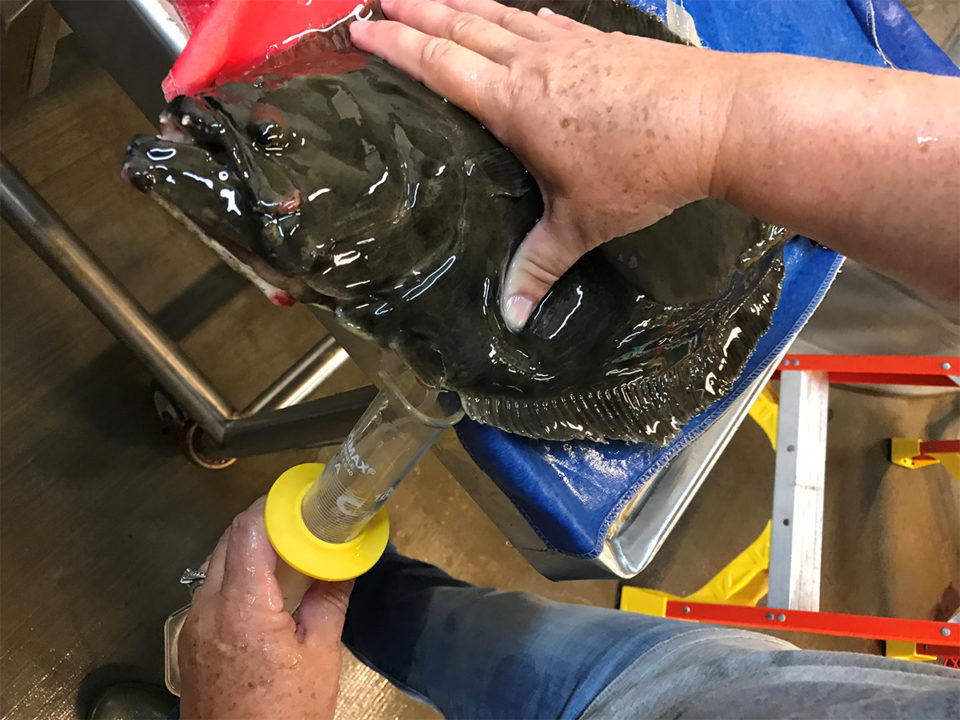
Larval development
Viable fertilized eggs hatch and become larvae within 72 hours. Southern flounder larvae require narrow environmental conditions: 16 degrees-C water temperature from 0 until 72 hours, after which the temperature is maintained between 17 degrees-C and 19 degrees-C. Other important water quality factors include dissolved oxygen (minimum of 7.0 mg/L O2), pH (~8.0) and salinity (~32 ppt).
Flounder larvae are bilaterally symmetrical fish, and utilize their yolk sac until 4 to 6 days post hatch (dph) (Fig. 3). At this time, the larvae are offered rotifers (Brachionus plicatilis) enriched with commercial products such as Orione Enrichment® (mention of any product names is not an endorsement). The enrichment is prepared by measuring out 10 grams of product, adding 100 mL of freshwater, and mixing the product for about an hour. The mixture is then transferred into graduated cylinders, and peristaltic pumps are used to deliver the enrichment mixture to rotifer culture tanks over a 24-hour period. These enriched rotifers are fed to the flounder larvae at a rate of 20-50 rotifers per mL.
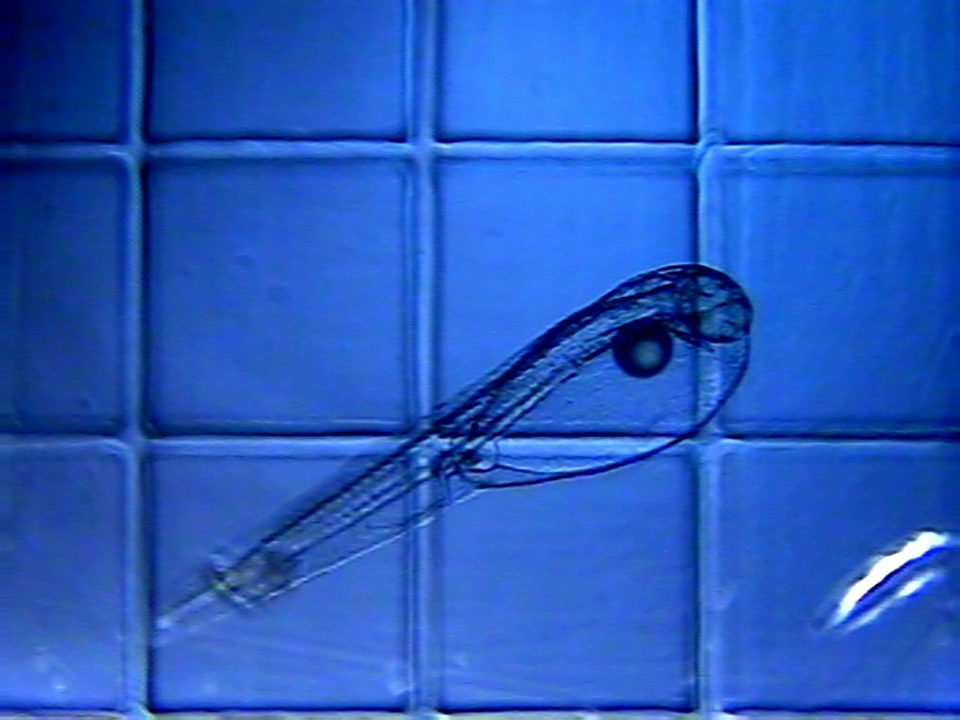
Enriched artemia (20-50/mL) are offered at about 25 dph and through the flounder fingerling stage. Artemia are cultured in plastic cones (~2 L). About 10 grams of artemia cysts are mixed with 50 mL of freshwater and the mixture is allowed to settle. After settling, the mixture is transferred into a prepared artemia cone filled with treated seawater and two aeration stones. The artemia hatch in 24 hours and used immediately.
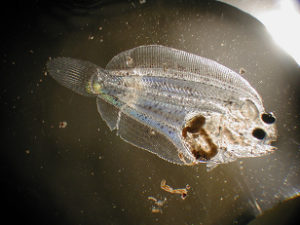
Depending on water temperature and feeding, metamorphosis (i.e., process of flattening out, Fig. 4) occurs between 28 and 40 dph in Texas, but is earlier in North Carolina stock (between days 19 and 24 dph). From an enriched artemia diet, flounder fingerlings are weaned onto formulated dry feed such as Otohime®. TPWD hatcheries target southern flounder fingerlings 60 to 80 dph for release into the natural environment (Fig. 5). Additional research is ongoing to determine the optimal size of releasing hatchery-reared flounder into the wild.
The 2017 production season
During the 2017 flounder production season, a total of 28,210 southern flounder cultured fingerlings were stocked into Texas bays and estuaries. Although significantly less than the 79,554 fingerlings stocked in 2016, the number stocked in the 2017 season exceeded the minimum annual quota of 25,000 fingerlings. TPWD has stocked a total of 404,848 southern flounder fingerlings into Texas bays and estuaries since 2009.
Southern flounder fingerling production and the number stocked declined in 2017 as compared the previous two years for several reasons. The primary cause was Hurricane Harvey. Hurricane Harvey’s eye passed about 30 miles north of the MDC on 25 August 2017 as a Category 4 hurricane. It caused extensive damage as it moved northward, then stalled near Houston, where ~60 inches (154 cm) of precipitation was reported. Fish culture operations were impacted at TPWD hatcheries, with storm winds, flooding, and electrical power outages affecting operations. Total damages at the MDC were more than $350,000. In addition, a rare snow event impacted the MDC in Corpus Christi on 8 December 2017. Temperatures fell below freezing and ~4 cm of snow accumulated.
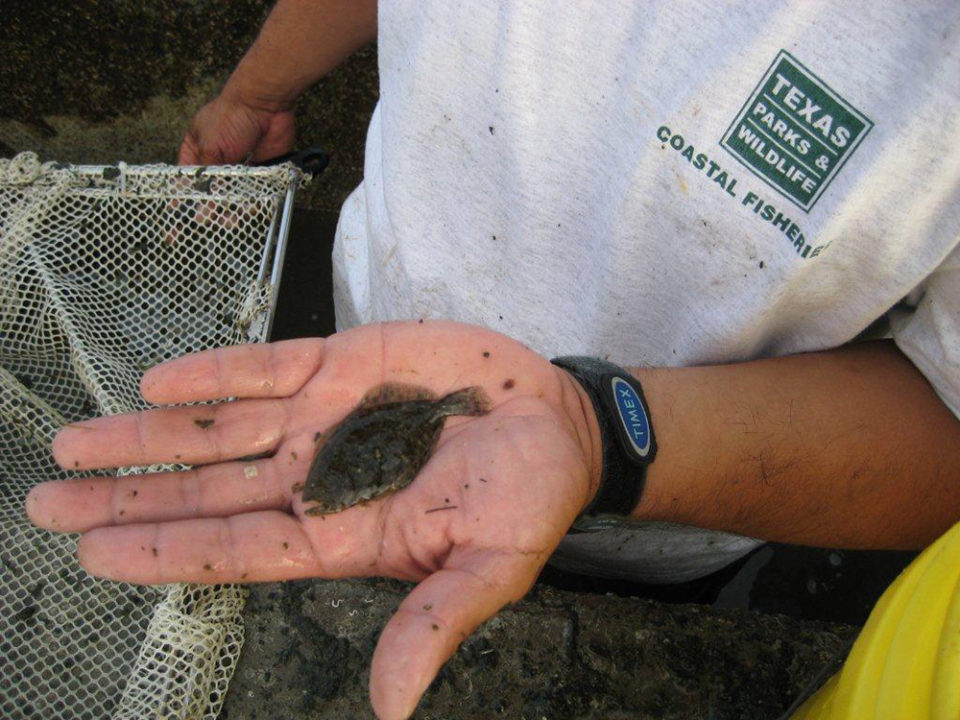
Perspectives
The TPWD’s Southern flounder stock enhancement program is still in its early stages of development when compared to its red drum and spotted sea trout stocking programs. Southern flounder larvae are delicate and exhibit a high degree of mortality during early culture stages. Larviculture improvements are a research focus for TPWD and university collaborators. The 2018 flounder production season is underway with some 80,000 fingerlings stocked to-date into coastal waters.
Southern flounder culture for stock enhancement has steadily improved since culture efforts by TPWD started in 2006. With construction of Southern flounder culture buildings at the MDC and SCT scheduled for completion in the winter of 2018, an increase in annual flounder fingerling production for purposes of stock enhancement is targeted.
References available from first author.
Authors
-

Carly L. Covington, M.S.
Texas A&M University – Corpus Christi
Department of Life Sciences
6300 Ocean Drive
Corpus Christi, TX 78412 USA -

John Scarpa, Ph.D.
Texas A&M University – Corpus Christi
Department of Life Sciences
6300 Ocean Drive
Corpus Christi, TX 78412 USA -

Robert R. Vega, Ph.D.
Texas Parks and Wildlife Department
Coastal Conservation Association Marine Development Center
4300 Waldron Road
Flour Bluff, TX 78418 USA
Tagged With
Related Posts

Health & Welfare
Dietary organic acids improve gut health, disease resistance in olive flounder
A study evaluated the effects of two organic acid blends on performance, gut health and disease resistance in olive flounder. The dietary organic acids were effective in lowering total gut bacterial counts, gut Vibrio counts and in conferring resistance against Edwardsiella tarda.

Health & Welfare
Korean researchers study protein levels, P:E ratios in olive flounder diets
The authors conducted research to determine the optimum dietary protein levels and protein:energy ratios for different age groups of olive flounders.

Responsibility
Aquaculture gives endangered totoaba a fighting chance
The tenuous fate of a pint-sized porpoise, the critically endangered vaquita, is linked to a fish targeted by poachers fueling China’s appetite for maws. The vaquita remains in peril, but aquaculture presents some hope for the totoaba.

Intelligence
As ocean temperatures rise, so too will vibrio outbreaks
A study using a half-century of data has linked climate change and warming sea temperatures with an increase in illnesses from the common vibrio bacteria. Shellfish growers, fighting a particularly virulent strain of Vibrio parahaemolyticus, are changing their harvest protocols.

